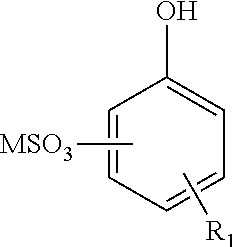Enhanced oil recovery surfactant composition and method of making the same
a technology composition, applied in the direction of sealing/packing, chemistry apparatus and processes, wellbore/well accessories, etc., can solve the problems of high capillary pressure, water not readily dispersing oil, and insufficient natural forces of the reserveoir, so as to improve the quality of oil recovery surfactant, reduce the amount of solvent used, and reduce the effect of solven
- Summary
- Abstract
- Description
- Claims
- Application Information
AI Technical Summary
Benefits of technology
Problems solved by technology
Method used
Image
Examples
example 1
Preparation of 41.4% Branched C20-24 Isomerized Normal Alpha Olefins (NAO)
[0153]The normal alpha olefins were received from ChevronPhillips Chemical Company, Woodlands, Tex. and found to have the following properties: 41.4% Methyl Branching
example 2
Measurement of % Methyl Branching and % Alpha-Olefin in C20-24 Isomerized NAO
[0154]Infrared spectrometry is used to determine the percentage methyl branching and percentage residual alpha-olefin of isomerized C20-24 NAO or isomerized alpha olefin (IAO). The technique involves developing a calibration curve between the infrared absorption at 1378 cm-1 (characteristic of the methyl stretch) measured by attenuated reflectance (ATR) infrared spectrometry and the percent branching determined by GLPC analysis of the corresponding hydrogenated IAO samples (hydrogenation converts the IAO to a mixture of paraffins in which the normal paraffin has the longest retention time for a give carbon number). Similarly, a calibration curve was developed between the infrared absorption at 907 cm-1 (characteristic of alpha olefin C—H stretch) determined by attenuated reflectance (ATR) infrared spectrometry and the percent alpha-olefin determined by quantitative carbon NMR. A linear least squares fit of ...
example 3
Preparation of 41.5% Branched C20-24 Alkylphenol
[0156]To a 10 liter, glass, four-neck flask fitted with a mechanical stirrer, reflux condenser and thermocouple under a dry nitrogen atmosphere was charged 2210 grams of melted phenol (23.5 moles) followed by 1450 grams (4.71 moles) of the isomerized C20-24 alpha-olefin from Example 1 containing 41.4% Branching. To this gently stirring mixture was added 290 grams of Amberlyst 36® acidic ion exchange resin obtained from Rohm and Haas, Philadelphia, Pa. (dried approximately 25 hours in an oven at 110° C.). The reaction temperature was increased to 120° C. and held for about 90 hours at which time the conversion was 42% (by Supercritical Fluid Chromatography). Additional Amberlyst 36® catalyst was added to the following total reaction times when conversion was not complete: 100 grams at 90 hours; 60 grams at 116 hours and 50 grams at 123 hours for a total catalyst charge of 500 grams. After 145 hours of reaction time, the conversion was 9...
PUM
 Login to View More
Login to View More Abstract
Description
Claims
Application Information
 Login to View More
Login to View More - R&D
- Intellectual Property
- Life Sciences
- Materials
- Tech Scout
- Unparalleled Data Quality
- Higher Quality Content
- 60% Fewer Hallucinations
Browse by: Latest US Patents, China's latest patents, Technical Efficacy Thesaurus, Application Domain, Technology Topic, Popular Technical Reports.
© 2025 PatSnap. All rights reserved.Legal|Privacy policy|Modern Slavery Act Transparency Statement|Sitemap|About US| Contact US: help@patsnap.com



